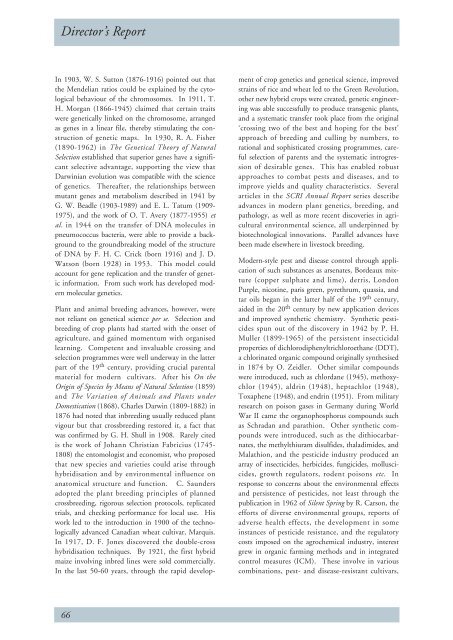PDF file: Annual Report 2002/2003 - Scottish Crop Research Institute
PDF file: Annual Report 2002/2003 - Scottish Crop Research Institute
PDF file: Annual Report 2002/2003 - Scottish Crop Research Institute
Create successful ePaper yourself
Turn your PDF publications into a flip-book with our unique Google optimized e-Paper software.
Director’s <strong>Report</strong><br />
In 1903, W. S. Sutton (1876-1916) pointed out that<br />
the Mendelian ratios could be explained by the cytological<br />
behaviour of the chromosomes. In 1911, T.<br />
H. Morgan (1866-1945) claimed that certain traits<br />
were genetically linked on the chromosome, arranged<br />
as genes in a linear <strong>file</strong>, thereby stimulating the construction<br />
of genetic maps. In 1930, R. A. Fisher<br />
(1890-1962) in The Genetical Theory of Natural<br />
Selection established that superior genes have a significant<br />
selective advantage, supporting the view that<br />
Darwinian evolution was compatible with the science<br />
of genetics. Thereafter, the relationships between<br />
mutant genes and metabolism described in 1941 by<br />
G. W. Beadle (1903-1989) and E. L. Tatum (1909-<br />
1975), and the work of O. T. Avery (1877-1955) et<br />
al. in 1944 on the transfer of DNA molecules in<br />
pneumococcus bacteria, were able to provide a background<br />
to the groundbreaking model of the structure<br />
of DNA by F. H. C. Crick (born 1916) and J. D.<br />
Watson (born 1928) in 1953. This model could<br />
account for gene replication and the transfer of genetic<br />
information. From such work has developed modern<br />
molecular genetics.<br />
Plant and animal breeding advances, however, were<br />
not reliant on genetical science per se. Selection and<br />
breeding of crop plants had started with the onset of<br />
agriculture, and gained momentum with organised<br />
learning. Competent and invaluable crossing and<br />
selection programmes were well underway in the latter<br />
part of the 19 th century, providing crucial parental<br />
material for modern cultivars. After his On the<br />
Origin of Species by Means of Natural Selection (1859)<br />
and The Variation of Animals and Plants under<br />
Domestication (1868), Charles Darwin (1809-1882) in<br />
1876 had noted that inbreeding usually reduced plant<br />
vigour but that crossbreeding restored it, a fact that<br />
was confirmed by G. H. Shull in 1908. Rarely cited<br />
is the work of Johann Christian Fabricius (1745-<br />
1808) the entomologist and economist, who proposed<br />
that new species and varieties could arise through<br />
hybridisation and by environmental influence on<br />
anatomical structure and function. C. Saunders<br />
adopted the plant breeding principles of planned<br />
crossbreeding, rigorous selection protocols, replicated<br />
trials, and checking performance for local use. His<br />
work led to the introduction in 1900 of the technologically<br />
advanced Canadian wheat cultivar, Marquis.<br />
In 1917, D. F. Jones discovered the double-cross<br />
hybridisation techniques. By 1921, the first hybrid<br />
maize involving inbred lines were sold commercially.<br />
In the last 50-60 years, through the rapid development<br />
of crop genetics and genetical science, improved<br />
strains of rice and wheat led to the Green Revolution,<br />
other new hybrid crops were created, genetic engineering<br />
was able successfully to produce transgenic plants,<br />
and a systematic transfer took place from the original<br />
‘crossing two of the best and hoping for the best’<br />
approach of breeding and culling by numbers, to<br />
rational and sophisticated crossing programmes, careful<br />
selection of parents and the systematic introgression<br />
of desirable genes. This has enabled robust<br />
approaches to combat pests and diseases, and to<br />
improve yields and quality characteristics. Several<br />
articles in the SCRI <strong>Annual</strong> <strong>Report</strong> series describe<br />
advances in modern plant genetics, breeding, and<br />
pathology, as well as more recent discoveries in agricultural<br />
environmental science, all underpinned by<br />
biotechnological innovations. Parallel advances have<br />
been made elsewhere in livestock breeding.<br />
Modern-style pest and disease control through application<br />
of such substances as arsenates, Bordeaux mixture<br />
(copper sulphate and lime), derris, London<br />
Purple, nicotine, paris green, pyrethrum, quassia, and<br />
tar oils began in the latter half of the 19 th century,<br />
aided in the 20 th century by new application devices<br />
and improved synthetic chemistry. Synthetic pesticides<br />
spun out of the discovery in 1942 by P. H.<br />
Muller (1899-1965) of the persistent insecticidal<br />
properties of dichlorodiphenyltrichloroethane (DDT),<br />
a chlorinated organic compound originally synthesised<br />
in 1874 by O. Zeidler. Other similar compounds<br />
were introduced, such as chlordane (1945), methoxychlor<br />
(1945), aldrin (1948), heptachlor (1948),<br />
Toxaphene (1948), and endrin (1951). From military<br />
research on poison gases in Germany during World<br />
War II came the organophosphorus compounds such<br />
as Schradan and parathion. Other synthetic compounds<br />
were introduced, such as the dithiocarbarnates,<br />
the methylthiuram disulfides, thaladimides, and<br />
Malathion, and the pesticide industry produced an<br />
array of insecticides, herbicides, fungicides, molluscicides,<br />
growth regulators, rodent poisons etc. In<br />
response to concerns about the environmental effects<br />
and persistence of pesticides, not least through the<br />
publication in 1962 of Silent Spring by R. Carson, the<br />
efforts of diverse environmental groups, reports of<br />
adverse health effects, the development in some<br />
instances of pesticide resistance, and the regulatory<br />
costs imposed on the agrochemical industry, interest<br />
grew in organic farming methods and in integrated<br />
control measures (ICM). These involve in various<br />
combinations, pest- and disease-resistant cultivars,<br />
66
















